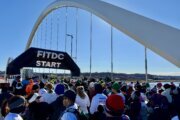PyeongChang, South Korea, is freezing, to say the least. In fact, the city’s epically cold temps — dipping down to negative 4 degrees Fahrenheit at times — are warping skis and freezing solid television equipment and anchors’ makeup. The brutal wind that’s postponed a few downhill skiing events hasn’t made things feel any warmer, either.
How does all of this affect how athletes are supposed to fuel themselves for what is likely the biggest competition of their lives? And, what can everyday athletes do to nourish themselves when the temps dip below freezing? Glad you asked. Here are the answers to those — and other — questions about cold weather fueling:
Do you burn more or fewer calories in cold weather?
Athletes burn more calories in cold conditions, though they need to actually be shivering for this to happen. Still, exercising in the cold will activate brown fat, which regulates body temperature by burning calories. Skiing, snowshoeing and running in the cold are all good ways to activate your brown fat, which can help you burn an additional 100 to 300 calories per day.
[See: 13 Fun Sports That Burn Calories.]
How much water should you drink when exercising outside?
Hydration needs can’t be ignored in cold weather, even though you may not feel thirsty or hot and sticky. Exercising outside still makes you sweat and lose plenty of water through respiration, so you have to make an extra effort to drink up. Hydration status is especially important for competitive athletes, since proper hydration enhances the body’s ability to regulate temperature and cool efficiently without elevating heart rate. It also minimizes muscle cramps, enhances mental function and motor control, supports the immune system and — probably most important for athletes with events on consecutive days — improves the ability to recover quickly from competition, according to the U.S. Olympic Committee.
To get specific, the USOC recommends drinking 16 ounces of water two to three hours before training, 8 ounces 15 minutes before and 16 to 24 ounces for every pound lost during training. While you may not be working out quite that hard on the slopes or at the gym, you can definitely use the committee’s guidance when it comes to the color of your morning urine. You are well-hydrated if your pee is pale yellow, but it’s time to spend some serious time with H2O if it’s deep yellow to brownish. It’s always smart to train with a bottle of water and refill it when you’ve polished it off.
What should I eat for cold workouts?
I grew up in frigid western New York state and spent many cold days (and nights) skiing in below-freezing temperatures. My mom always made sure I had a hearty breakfast before I left the house; usually oatmeal topped with maple syrup, fruit and a dollop of cream cheese. From the dispatches I’ve been reading from PyeongChang, this isn’t too far off from what the winter Olympians are eating — and that’s a good thing. Oats provide complex carbohydrates, which break down slowly, and also contain fiber and resistant starch, which help keep athletes feeling full until their next meal or snack. And some fat — in the form of nuts, nut butter or coconut oil — will ensure that the meal doesn’t digest too quickly.
[See: Wish You Were Headed to the Olympics? How to Train for 9 Winter Sports.]
How many calories do Olympic athletes eat?
Depending on the size of the athlete and the demands of his or her sport, an Olympian may eat between 500 and 1,500 calories for breakfast. Their daily calorie intake is about 3,000 to 4,000 calories — about twice what the average person needs.
According to the USOC’s “plate,” athletes also tend to eat differently depending on what stage of training they’re in — easy, moderate or hard/race day. (By the way, in the world of a competitive athlete, an “easy” day means one workout, a “moderate” day is one strength workout plus a technical training session and a “hard” day is two workouts or a day of competition. Kind of makes me reconsider calling my 3-mile run “hard,” but it does make sense for us all to adjust our diets as our level of activity changes.)
What do Olympic athletes eat?
According to the USOC’s guide, athletes should eat about the same amount of protein daily, whether or not it’s an easy, moderate or hard day of training. What should change is the carbohydrate content — it goes from one-quarter of the plate on an easy day to half of the plate on a hard day.
You can easily translate that to your own training by visualizing an easy day plate with one-quarter of the plate filled with scrambled eggs; another quarter filled with whole-wheat toast or pancakes, oatmeal or other carbs; and the rest with fruits and veggies. On a hard day (say you’re running 10 miles or going for a full day of powder on the slopes), you’ll up those carbs to half of the plate, keep the protein at one-quarter and drop the fruits and veggies down to a quarter. There’s nothing worse than bonking when you’re trying to take that last hard run of the day, or attempting to kick it into a high gear on the final uphill of a race.
[See: 8 Insider Tips to Crush Your Next Ski Trip Safely.]
When do Olympic athletes eat?
The National Academy of Sports Medicine recommends that in cold weather, athletes eat a carb-rich snack 30 to 60 minutes before training to make sure muscle glycogen (your body’s fuel source for exercise) is at its peak. If you’re out there for an hour, drinking water is adequate. Any longer than that — say, an adventurous day of snowshoeing — and you need to plan for a snack with 30 to 60 grams of carbs per hour. That might be a granola bar, oatmeal or half of a whole-wheat bagel. For easy pre- and post-workout snack ideas, click here.
If you’re lucky enough to have a ski or snowboard trip planned for winter or spring break, fuel up and enjoy! And whether you’re an armchair athlete, weekend warrior or fitness fiend, take some inspiration from these Winter Games.
More from U.S. News
8 Health Challenges Facing Olympic Athletes
5 Pre-Performance Rituals to Watch for This Olympics
The Best Olympic Sport for Your Body Type
Here’s How Super Cold Weather Affects Winter Olympians’ Diets originally appeared on usnews.com







